Circulation Creams
In 1937, the film star Constance Bennett [1904-1965] appeared in a promotional movie that supposedly followed her morning beauty routine. The film was part of a promotional campaign for Constance Bennett Cosmetics, a short-lived company – established in Hollywood in 1937 – which made a modest skin-care and make-up range. It did reasonable business early on but things deteriorated in the 1940s and it disappeared after the Second World War.
The line was packaged in deep-rouge containers with Constance’s name and/or a small crown displayed prominently on the lid. In the 1930s, the make-up range included Glow Base, Creme Rouge, Lipstick and Face Powder, while the skin-care products consisted of Cleansing Cream, Stimulant Cream, Complexion Mask, Absorbent Cream, Protective Lotion and Champagne Astringent, not all of which are used in the film.
Above: 1937 Constance Bennett in ‘Daily Beauty Rituals’.
Most of the skin-care items mentioned in the promotional movie would be familiar to modern audiences, except perhaps for the Stimulant Cream.
Now I apply my stimulant cream. Just for a few minutes because it only starts stimulation. Remember I said stimulation is the basis of my skin treatment. Just like brushing your teeth is stimulation for your gums and makes your gums healthy, and brushing your hair is stimulation your scalp makes your hair strong and healthy and, oh I could go on for hours.
(Constance Bennett presents her “daily beauty rituals”, 1937)
The Stimulant Cream used by Constance in her morning routine sounds like what were also called ‘Circulation’ or ‘Blood Glow’ creams, referred to as such because of their effect on circulation.
Circulation
Most beauty experts in the 1930s thought that good circulation was one of the foundations of great looking skin. This idea – which had been around well before 1900 – was the basis for many facial treatments including massage, patters, high frequency and heat, all of which were used to increase the flow of blood to the skin, helping to nourish it and remove toxins, thereby rejuvenating it, smoothing out wrinkles and improving its colour.
There are two distinct schools of thought on Beauty Culture. On the one hand, you are told to treat the face very gently; to smooth in your cream, leave it on for a specified length of time, and then wipe it off—again very gently of course. In other words, you must do your best to maintain the status quo.
But the beauty of the skin and the freshness of the facial muscles depends on supplies of fresh blood brought up to the surface. And this brings us to the second school of thought, which maintains that you should produce, by massage and stimulation, sufficient heat to ensure the elimination of toxins from the skin, as well as maintain a full supply of the vitalising agents necessary for the nourishment of the muscles and the growth of new cells.(Brooks, 1946, p. 73)
Circulation cosmetics
As the name suggests, the primary function of a circulation cream or lotion was to stimulate sluggish, sallow skin by improving its blood circulation.
Dorothy Gray’s Circulation Ointment. Eliminates the poisons; stimulates and rejuvenates sluggish and sallow skins. Brings the natural color to cheeks.
(Dorothy Gray advertisement, 1926)
Perhaps the most remarkable of all Miss Denney’s Herbal Preparations is her Circulation Mixture. It is marvelously [sic] effective in brightening dull, sallow skin by developing vital circulation through the skin tissues. Only a few applications of Herbal Circulation Mixture will bring the appearance of health and vitality to the most sallow skin. It can be used on the most sensitive skin.
(Frances Denny advertisement, 1930)
Although skin tonics and astringents were often used to stimulate blood flow to the skin this was primarily due to their cooling effect on the skin. Circulation creams worked by including one or more skin irritants – such as balsam of Peru, cinnameine (the clear oil of balsam of Peru), benzaldehyde and/or capsaicin (found in chili peppers) – in their formulation.
See also: Skin Tonics, Astringents and Toners
Some of the compounds used in circulation creams have a history that extends back into herbal preparations used in previous centuries. They induced a visible reddening of the skin which suggested an ‘improved circulation’ and many were described as being ‘stingy’. Example formulae are given below:
Stimulating cream for dry flaccid skins with a tendency to wrinkles.
Essence of cinnamon 10 drops Balsam of Peru 30 drops Essence of eucalyptus 20 drops Styrax ointment 1 gramme Oil of vaseline 25 gramme Carbonate of calcium 12 gramme (Muller, 1916, p. 125)
Balsam of Peru 3 parts Castor Oil 3 parts Alcohol S.D. 50 parts Benzaldehyde 0.5 parts Water to make 100 parts Procedure: Mix the balsam with the castor oil and benzaldehyde, dissolve in alcohol. Add the water to the alcohol mixture slowly, and fill directly into bottles under agitation, as both balsam and oil will separate coming to the top and some to the bottom. Label: Shake Well Before Using. Directions for Use: Always precede and follow the use of stimulating lotions with an application of cold cream. Apply lotion with cotton over neck, throat and face but avoid eye area. Use no more than once a week.
(deNavarre, 1941, p. 300)
Most of these cosmetics were sold as creams rather than lotions as they were easier to apply. Given that they contained irritants they were not left on the skin for very long. Constance only applies her Stimulant Cream momentarily before taking most of it off and covering it with a mask, the residual remaining under the mask for 15-20 minutes, the normal suggested time for this type of cosmetic.
Barbara Gould Circulation Cream
Stimulates Gently—Barbara Gould Circulation Cream snaps the warm, youth-giving blood in a pulsating rhythm to the surface of the complexion. Only such healthy circulation can nourish glands and cells, and keep contours firm and young. Use this circulation Cream after a thorough cleansing with Barbara Gould Cleansing Cream. You need leave it on only twenty minutes.(Barbara Gould advertisement, 1935)
Circulation creams and lotions were not applied around eyes or on the lips as the skin there was far to sensitive. If a formulation was particularly strong a cold cream cleanser could be used rather than soap or water, as the cream would leave a film that would provide some protection – this is the procedure Constance used. The circulation cream could also be applied over another cream if the skin was sensitive. This approach was recommended by Frances Denney when using her Herbal Circulation Mixture.
First, as always, cleanse the skin and remove every trace of cream. Next, if the skin is sensitive, spread a thin layer of Tissue Cream. Then apply.
(Frances Denney, 1933)
After they were removed, circulation creams could also be followed with another skin cream to help soothe any residual irritation.
It might be thought that being ‘stingy’ would make a product like this unsellable but clearly this was not the case. A similar situation occurred when alpha-hydroxy-acids (AHAs) were introduced into cosmetics later in the century. These were also viewed as being ‘stingy’ or ‘bitey’ but that also did not affect their sales.
Limiting the amount of the irritants in these circulation creams and lotions would reduce their bite but it would not affect their ability to act as allergens and for this reason some cosmetic chemists thought their use should be restricted to professionally trained operators (deNavarre, 1941, p. 300). Similar debates took place with the introduction of AHAs.
Circulation creams and their like largely disappeared from general cosmetic counters in the 1940s. However, given that many of their active ingredients were found in ancient herbal recipes, products similar to those of the past can still be purchased today from some natural therapy suppliers. Having said that, anyone thinking of buying and using one of these products should first look at its ingredient list to assess any potential irritating or allergenic effects.
First Posted: 17th November 2014
Last Update: 13th February 2023
Sources
Belanger, E. J. (1958). Modern manufacturing formulary compiled for chemists, manufacturers, pharmacists, technicians, and students. New York: Chemical Publishing Co., Inc.
Blood glow or circulation creams. (1932). The Perfumery and Essential Oil Record. June, 182-183.
Brooks, N. (1946). Beauty through circulation. Harpers Bazaar (English), 36(1), 73.
deNavarre, M. G. (1941). The chemistry and manufacture of cosmetics. Boston: D. Van Nostrand Company.
Muller, R. W. (1916). Hygiene of the face and cosmetics guide. New York: E. P. Dutton & Co.
Constance Bennett presents her “daily beauty rituals” [Film]. (1937). Hollywood: Hal Roach Studios.

1924 Primrose House Balsam Tissue Stimulant. Although labelled as a stimulant cream this product was an astringent. Primrose House also sold a Circulation Cream.
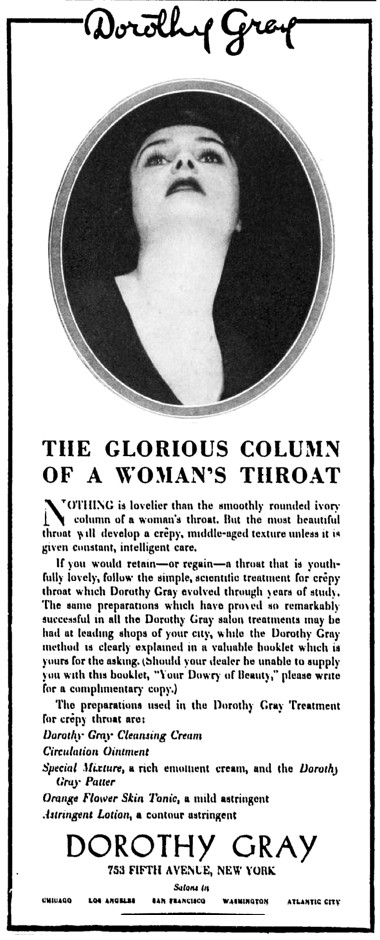
1928 Dorothy Gray Circulation Ointment.
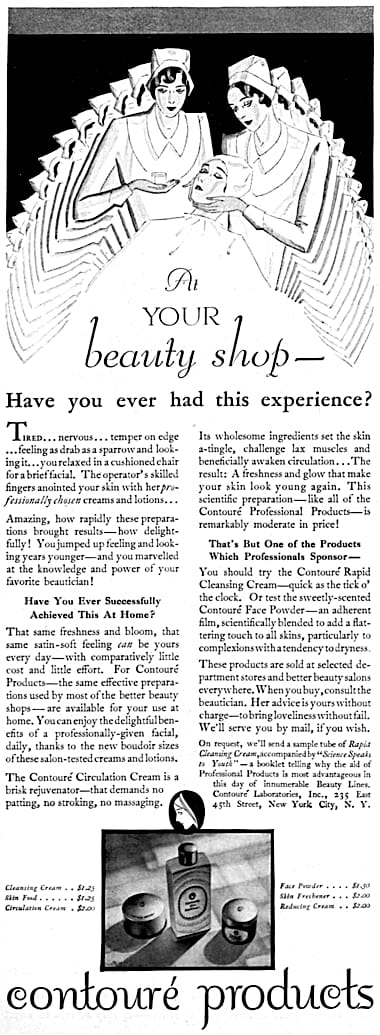
1929 Contouré Circulation Cream.
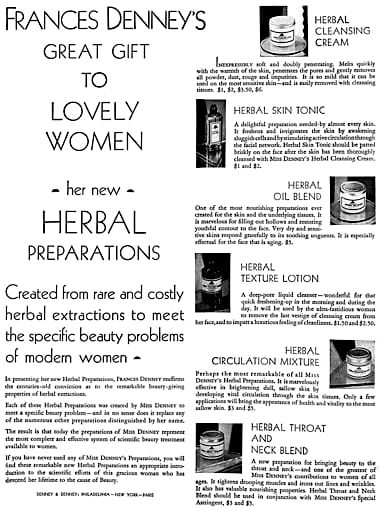
1930 Frances Denney Herbal circulation Mixture.
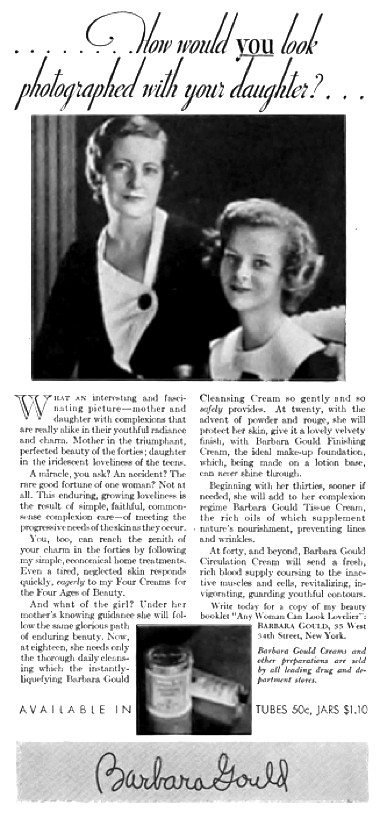
1933 Barbara Gould Cleansing Cream and Circulation Cream.
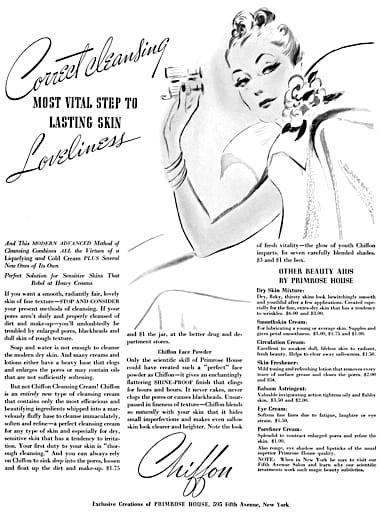
1938 Primrose House Circulation Cream.
